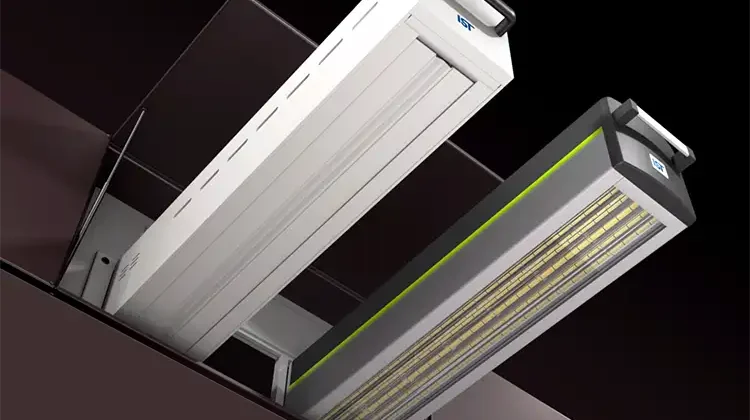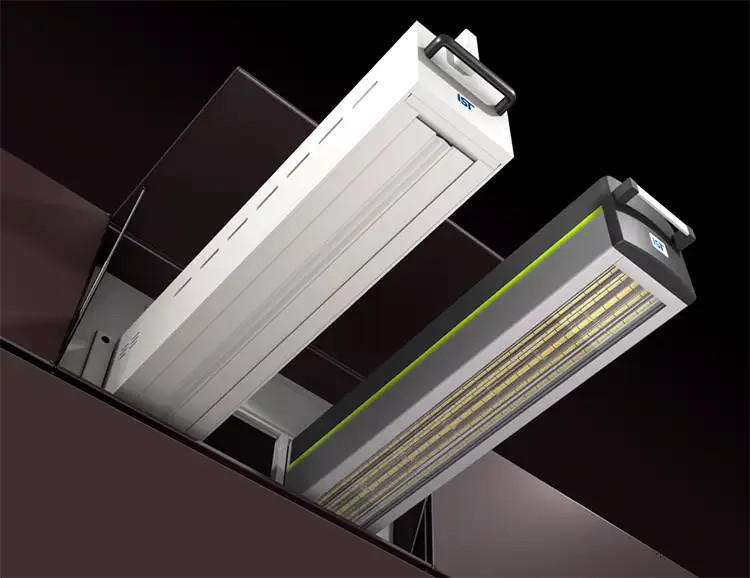
Via Bill Bonallo, president/CEO; and Errol Moebius, vp, IST America Corp.
Introduction
Dry. Cure. Bond. Adhere. Over the past several decades, ultraviolet (UV) printing, often referred to as energy-curable, has gone from a nascent, specialized, add-on press “drying” option to the prolific print solution across commercial and packaging segments that it is today. Yet as the technology continues to advance to meet changing requirements of the industry, it’s critical that printers and converters have supplier partners they trust to guide them in integrating the best-fit solutions for their specific application ranges.
In this article, IST America President/CEO Bill Bonallo and the company’s vice president, Errol Moebius, share their guidance for printers and converters who may be seeking to level up their UV-printing and curing capabilities, or for companies that are bringing UV technology onto their production floors for the first time. Drawing on a collective 60-plus years of experience in the industry working with UV, Bonallo and Moebius are authorities on UV and energy-curing technologies in today’s marketplace.
Initial key questions to ask
When asked what he considers to be critically important when a company is thinking about venturing into some kind of UV integration for the first time, Moebius comments, “I think that first and foremost, the customer needs to define what they expect the UV technology to provide. In other words, is it just improved throughput and shorter production times that are the objective? Is expanding capabilities that offer the ability to print on specialty / nonporous substrates the goal? Is the ability to greatly expand overall application options, including ink and coating combinations, to a new market important? Or do you need to compete with others in the industry that already run UV? Clearly defining expectations up front, and then thinking short-, medium- and long-term objectives, is the only way to know how to select and configure a UV-curing system to meet and hopefully exceed your expectations.”
Bonallo stresses that there are additional considerations to keep in mind to ensure a company’s success. “UV technology is an awesome tool, and we’re not in the UV days of the past,” he says. “In the beginning, it was reserved for highly specialized applications, and only the fearless and the brave dared going down that path. Today, that is not the case. That being said, UV comes in a few different flavors (for the purposes of this topic, we will reference traditional arc-lamp and LED as the most common light sources). To decide which flavor is best for you depends again on what you are trying to achieve, what substrate you are running and if that substrate is temperature-sensitive or dimensionally unstable. Also critical are the substrate’s end-use requirements, including durability, gloss, matte, COF, availability of spot, special match colors and more.

“UV-LED, which was wildly over-hyped during its introduction, has established itself as a solid alternative as a UV curing light source, depending on the application,” Bonallo continues, “but still is accompanied by highly optimistic performance claims. Traditional UV remains the light source of choice for the overwhelming majority of packaging printers in North America” (see Figure 1).
Both LED and traditional UV use UV-curable inks and coatings, which require UV-rated press washes to remove them from rollers, blankets and cylinders. UV-compatible ink and water system rollers and rubber blankets are required, regardless of the UV light source selected. There are additional press-related preparations required for the correct and factory-approved installation of a UV system on most presses, such as automatic roller-wash systems and even cylinder-gripper material on occasion.
Product range, inks, substrates all determine correct components
When IST America works with customers, Bonallo explains, it gives close consideration to the application range of the customer and the specific requirements of each printer’s roster of end-products. “It’s important that we provide customers with a very clear view of what can be accomplished and how to configure the components of their UV system on their press,” he says.
“After that, it comes down to flexibility,” he continues. “A packaging printer running paperboard will need a different system than a commercial printer running a mix of specialty non-porous substrates along with paper stocks. For many applications, the number of UV-curing modules between the print units is dictated by what ink a converter chooses to run, how important it is to truly trap (ink trapping) between colors, the ink coverage of the graphics being printed, how much opaque or metallic inks are running and in which positions, what types of substrates are being used, and what the target is for press speed. These are only some of the variables that go into making a successful choice when it comes to UV technology.”
Impact of packaging graphics on UV curing
To consider the way UV technology is evolving alongside graphic and print-definition standards, one needs to look no further than some of this year’s most significant design trends. “We’re seeing ‘text-centric’ designs proliferate on retail shelves and in commercial-print materials,” Bonallo adds. “In the label and flexible-packaging sector, ultra-opaque colors that pop and standout typefaces that use sharp, contrasting colors remind us that type design and styling are art forms in their own right. UV printing reinforces these design trends, allowing the font to carry more brand messaging and design prowess than ever before. In the carton sector, brands are taking print to the next level by using sophisticated faux-3D effects that differentiate high-end products in front of a more discerning consumer. UV enables carton converters to hit higher-definition graphics with these applications.
Moebius explains, “On the packaging side, there is a whole range of things that are influenced by the type of curing technology you’re going to use and the type of adhesion that is necessary. Converters need to understand exactly what their customers require. Do they need something that’s sparkly and glitzy? Do they need something that’s extremely hard and durable with maximum rub resistance? Or do they need something just for a special effect? This is where working with the right UV-technology supplier is critical because there are so many variables, and these applications can have rigorous performance requirements.”
Not a ‘one-product-fits-all’ solution
Bonallo adds that lamp positioning in relationship to the substrate, access to the press and heat management are all critical for every application and that UV is not a ‘one-product-fits-all’ solution. “As with many things, not all UV technology is created equal,” he says. “We’re factory-approved by virtually every major sheetfed- and web-press system manufacturer in the world, and this designation isn’t just given out, it’s earned. This means that every one of our UV-curing systems must meet the rigid specifications of the OEM-press suppliers.
“The heat generated by the traditional UV process and its potential effect on press components is vital to understand. In some cases, over 1,600 individual, fixed-mounted temperature sensors are positioned between and within each print unit, and test runs of up to 100,000 sheets are completed at 100% UV-system output over varying speeds. Each company has a unique application range with its own set of print requirements, and our job is to make sure converters succeed regardless of which press system they’re using.”
As the bar for print-definition and press-production performance constantly is being raised, when it comes to optimal UV performance, the printer-supplier partnership is more important than ever, Bonallo and Moebius stress. A collaborative synergy between press suppliers, ink and coating companies, and UV-technology manufacturers is an essential formula for a printer’s success. And as print and production standards continue to rise, it’s only going to become more imperative that printers have a proven and reliable network of suppliers working together to support their new and changing requirements in the future, say the authors.
Bill Bonallo is president/CEO of IST America Corp. (Shorewood, IL). He can be reached at 360-944-6007, email: Bill.Bonallo@usa.ist-uv.com, www.ist-uv.com/en-us.
Errol Moebius is vice president of IST America Corp. He can be reached at Errol.Moebius@usa.ist-uv.com.

